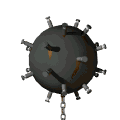The sunken European and Chinese antiques cargo
The Antiques of the Welsh Prince
By Pascal Kainic
From a laconic account by Captain H.M Butlin:
The cargo ship from the Company Furness & Whity and Co, of 5148 tons, was en route from London to New York and lost on a mine on the 7th December 1941 at 10.25 A.M
She was in the convoy FN.71
Commodore: Commander Bartley in SS Poznan (Polish)
Vice Commodore: Lt-Commander Lemper in SS Katowice (Polish)
Escorts: HMS Whaddon and HMS Sleipner
Additional escorts: HMS Mallard, Lady Philomena, Campbell, Mendip, Lydd
"We were bound from Southend to Methil with 1470 tons of general cargo, including military stores and were armed with a 4” gun, 2 Hotchkiss, 2 Marlins, 2 Twin Marlins, 2 Lewis, 1 Holman projector, 2 P.A.C rockets, 2 depth charges and a balloon,which was flying when the explosions occurred. The ship was degaussed and the apparatus was working. The crew, including 4 naval and 4 military gunners and myself numbered 49, of whom 3 were slightly injured. The confidential books and wireless books were thrown overboard in 2 steel boxes.
We left Southend at 0855 GMT on the 6th December and proceeded in single line formation astern of n°20 in convoy F.N.71. About 1500 GMT, the convoy was divided into 2 columns and we took position n°22, the 7th ship in the port column.
We proceeded without incident until 1900 GMT when we heard 2 explosions and saw red flares on the starboard quarter, about ½ mile astern of us. We presumed that a ship had been mined. We did not see any flash from gunfire.
During the night, we fell astern of our position in poor visibility and lost sight of the ship ahead, a coaster of about 400 tons. About 0700 GMT, on the 7th, we return to our position in the convoy, astern of n°20, a Norwegian vessel. Then, we saw a huge column of water about 5 miles ahead of us and presumed it was a mine exploding. Visibility was good at the time. About 1000 GMT, when approaching the East Dudgeon Buoy and a wreck buoy, we made an alteration of about 10° to port to allow room for the ship on our starboard beam to clear the wreck buoy.
All the ships in the starboard column were steering over to the westward in order to clear the wreck buoy. There was a strong wind on the beam at the time and the vessels were making a lot of leeway. After clearing this buoy, we got into position again.
At 1025 GMT, half an hour after passing the East Dudgeon buoy, in position 5 cables 110° from n°59 buoy, in about 9 fathoms of water, 290° Spurn Point 31 miles, a violent explosion lifted the forepart of the vessel and a few seconds later there was a second explosion. The sea, at the time, was rough, wind was N.W force 5/6, weather was fine and visibility very good and clear. We were making 6 knots on course 360° magnetic. There were 5 or 6 ships ahead of us, and all the vessels were following each other closely and must have passed over or very close to this spot.
The concrete slab protection on the bridge collapsed and the bridge was covered with debris. The compass was blown on to the deck, and most of the fire extinguishers which were fitted on the usual brackets with hoops to hold them, were thrown up and burst.
I told the Chief and 2nd officer to get the boats lowered, and whilst they were doing this I went down to my room and collected my valise containing the ship’s register, official logbook etc… which I brought on deck and placed on the port lifeboat. They were subsequently lost as when the lifeboat arrived alongside HMS Mallard, the valise was thrown up o the hands standing at the rail but was not caught and fell into the sea…"
The cargo
1470 tons general (from which 7 cases, 9 packages and 5 boxes of antiques and silverware), 80 tons cocoa residue, 130 tons wet salted hides, 600 tons chalk, 17 tons lorries, 90 tons Gov. stores
The treasure
the Welsh Prince was carrying several boxes of antique and modern china, silverware for delivery in New-York. Amongst the long list of items:
- A pair of old Sheffield plate candlesticks
- 18 old Sheffield plate silver on 4 claws & ball
- Old Sheffield plate basket with handle
- Georgian silver Inkstand
- Pair of Georgian silver sugar tongs
- Set of 6 Georgian silver wine coaster
- Pair of Georges III chamber candlesticks & snuffer 18ozs
- Sheffield plate oblong mirror plateau 26” long
- Staffordshire dinner service (84 pieces)
- Old Turkish Zataquan sword
- Georgian & Indonesian swords
- 2 sacrificial swords from Nepal
- 5 Georgian swords with ivory hilts etc… etc…
The wreck site
The wreck was upright with 15 feet of masts and 5 feet of the navigation bridge showing at low water, but the masts were about 700 feet apart, indicating that the wreck had broken in 2 abaft the bridge.
Salvage was considered impracticable. In 1946, the wreck was to be dispersed, but this has not yet been done by 1948, when the wreck was noted has having shifted and has being a danger to shipping.

Comments
-

- 1. Tatiana On 26/11/2008
Was the treasure finally recovered ?
It's incredible ! I can't believe no one has ever thought looking for this antiques...
Add a comment